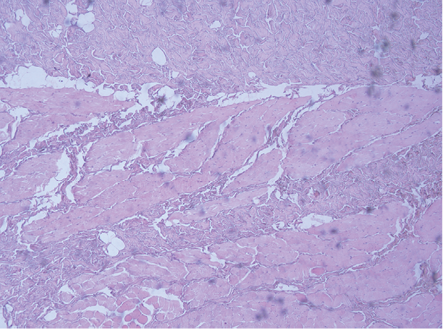Hypertrophic Left Calf and Multiple Flesh-coloured Subcutaneous Tumours in a 5-year-old Girl: A Quiz
Maartje J. van Geel1, Marc Wijnen2, Esther P. A. H. Hoppenreijs3, Nicole Gierenz4, Liesbeth Spruijt5, Martine P. A. van Koolwijk5, Uta Flucke6, Willeke A. M. Blokx6 and Marieke M. B. Seyger1
Departments of 1Dermatology, 2Surgery, 3Pediatric Rheumatology, 4Pediatric Gastroenterology, 5Genetics, and 6Pathology, Radboud university medical center, René Descartesdreef 1, NL-6500 HB Nijmegen, The Netherlands. E-mail: Maartje.vanGeel@radboudumc.nl
A 5-year-old Caucasian girl was presented for a second opinion due to a 4-year history of progressive, painful swelling of her left calf. Magnetic resonance imaging (MRI) of the left calf performed elsewhere, suggested chronic fasciitis but histology from this site was not conclusive. In addition, 2 subcutaneous skin tumours in the paraspinal region were observed since 2 months. Personal and family histories were unremarkable. Physical examination showed generalised hypertrophy of the left calf. On the back there were 2 flesh-coloured, soft subcutaneous tumours, the diameter of the largest tumour was 3 × 4 cm. X-ray showed hypertrophy of the left distal fibula with irregular bone structure and some medial sclerosis; there was no cortex interruption. Ultrasound of the tumours on the back revealed thickening of subcutaneous structures; there was no flow on Doppler signal. The results of a skin biopsy of the involved skin on the paraspinal region are shown in Fig. 1.

doi: 10.2340/00015555-1779
What’s your diagnosis? See next page for answer.
Hypertrophic Left Calf and Multiple Flesh-coloured Subcutaneous Tumours in a 5-year-old Girl: A Comment
Acta Derm Venereol
Diagnosis: Gardner-associated fibroma
Based on the histological findings in combination with multiplicity of the lesions, location and deep extension, the option of a Gardner-associated fibroma (GAF) was suggested. The lesion showed no cellular fascicular growth indicative of desmoid fibromatose. Immunohistochemically, nuclear expression of beta-catenin was absent. DNA analysis revealed a heterozygous pathogenic frame shift mutation in exon 15: c4510_4513del (p.Ser1504fs) in the Adenomatous polyposis coli gene (APC), which confirmed the diagnosis of Gardner’s syndrome (GS). In both parents the pathogenic mutation in the APC gene was absent. Ophthalmological screening revealed no abnormalities, particularly no signs of congenital hypertrophy of the retinal pigment. An orthopantogram showed no cysts, odontomas, osteomas or other abnormalities. Gastroscopy revealed mild gastritis due to Helicobacter pylori gastritis and a small duodenal polyp with the histology of an adenoma with low-grade dysplasia. Colonoscopy including histological exam demonstrated no abnormalities. On abdominal ultrasound performed to exclude an intra-abdominal fibroma or desmoid tumour, a round, homogeneous, echo poor, sharply demarcated lesion with a diameter of 3 cm was found. Subsequent MRI showed an oval, sharply demarcated tumour, diameter 27 × 24 × 20 mm, originating from the left adrenal gland, most probably a Gardner adenoma. So far there is neither suspicion of malignancy, nor evidence that the tumour is producing hormones. The subcutaneous tumours were excised because of mainly pain symptoms. Histological examination of the excision biopsy of the swelling on the left calf demonstrated desmoid type fibromatosis. Mutation analysis of the tumour confirmed the known germline pathogenic APC mutation c.4510_4513del (p.(Ser1504fs) and a somatic mutation c.4132C>T (p.(Gln1378fs).
GS is an autosomal dominant inherited disease characterised by the triad of gastrointestinal polyps, multiple osteomas and mesenchymal tumours of the skin and soft tissue (1). GS and familial adenomatous polyposis (FAP) are considered to be variants of the same disease. Both are caused by mutation in the APC gene located on chromosome 5q21 (1). The mean age at diagnosis of GS is 22 years, but symptoms may present between 2 months and 70 years (1). The cutaneous and bone abnormalities precede development of polyposis with approximately 10 years (1, 2). Most common cutaneous manifestations are epidermoid or sebaceous cysts (66%) (1) that usually occur on the face, scalp (3) and extremities. Other cutaneous manifestations of GS include fibromas, neurofibromas, lipomas, leiomyomas and pigmented skin lesions (1).
Differential diagnosis of GAF includes a vascular or lymphatic malformation, fibrous hamartoma, (desmoid type) fibromatosis, lipofibromatosis, collagenous fibroma, infantile fibromatosis, nuchal type fibroma or collagenoma (6).
The diagnosis of GS can be made by genetic testing or by colonoscopy showing multiple polyps (1). Because of the increased risk of malignancy, bowel surveillance is advised starting from the age of 10–12 years. The occurrence of gastrointestinal dysplasia or even carcinoma at a very early age (e.g. before 10 years) was already reported in some cases (3–5).
Fibroma as the presenting sign of GS is rare and mostly reported in conjunction with a family history of GS or polyposis (6). In these cases, GAF is related to young age and to FAP and the desmoid type fibromatosis (7). GAF as the presenting sign of a spontaneous mutation in the APC gene was already hypothesised by Wehrli et al. (6). In this report we illustrate that GAF can serve as the sentinel event, identifying children with de novo mutations in the APC gene. So far, it is not known whether the occurrence of GAF at a very early age also will be related to the development of polyposis and adenomas at earlier ages.
REFERENCES
